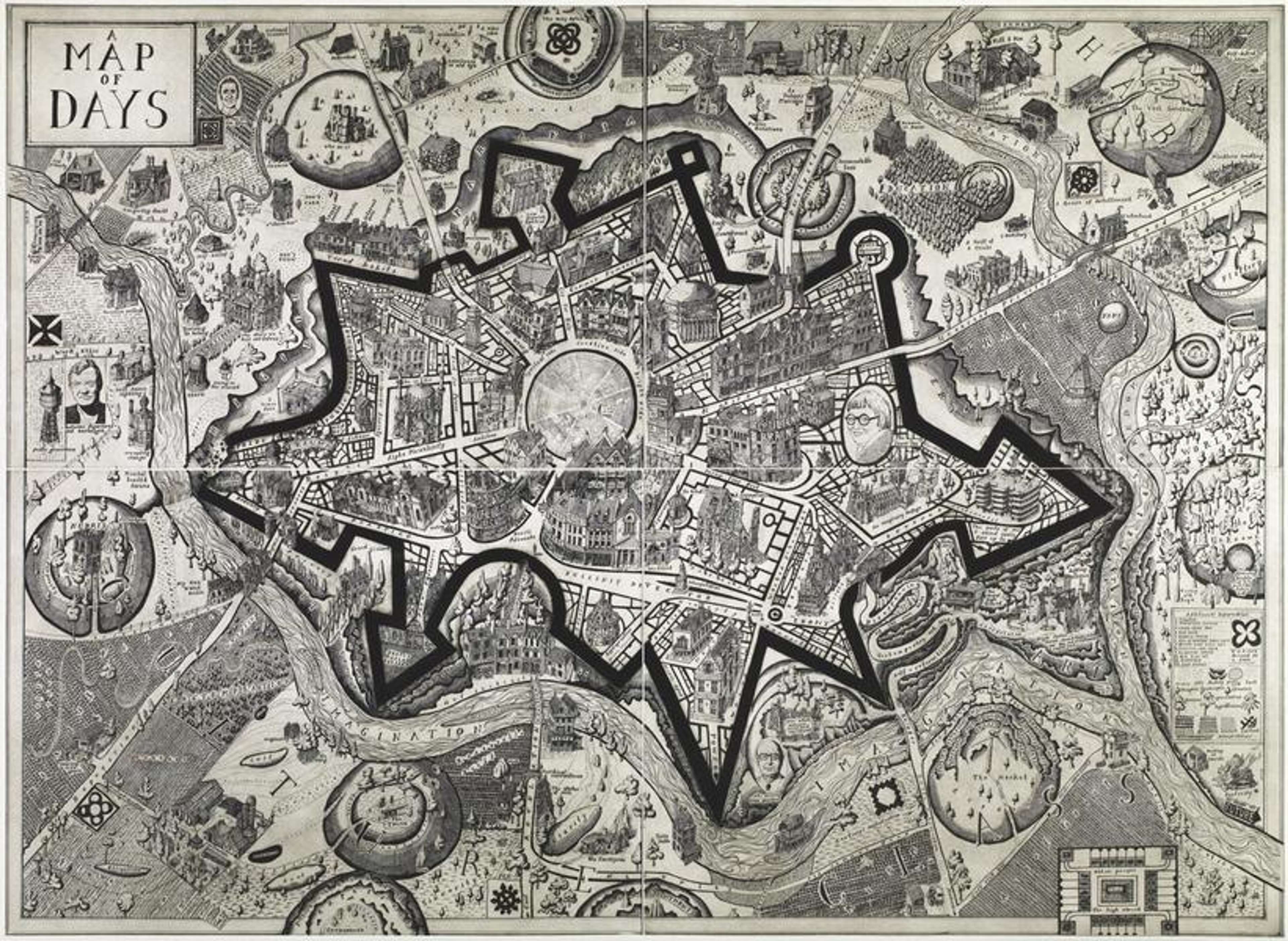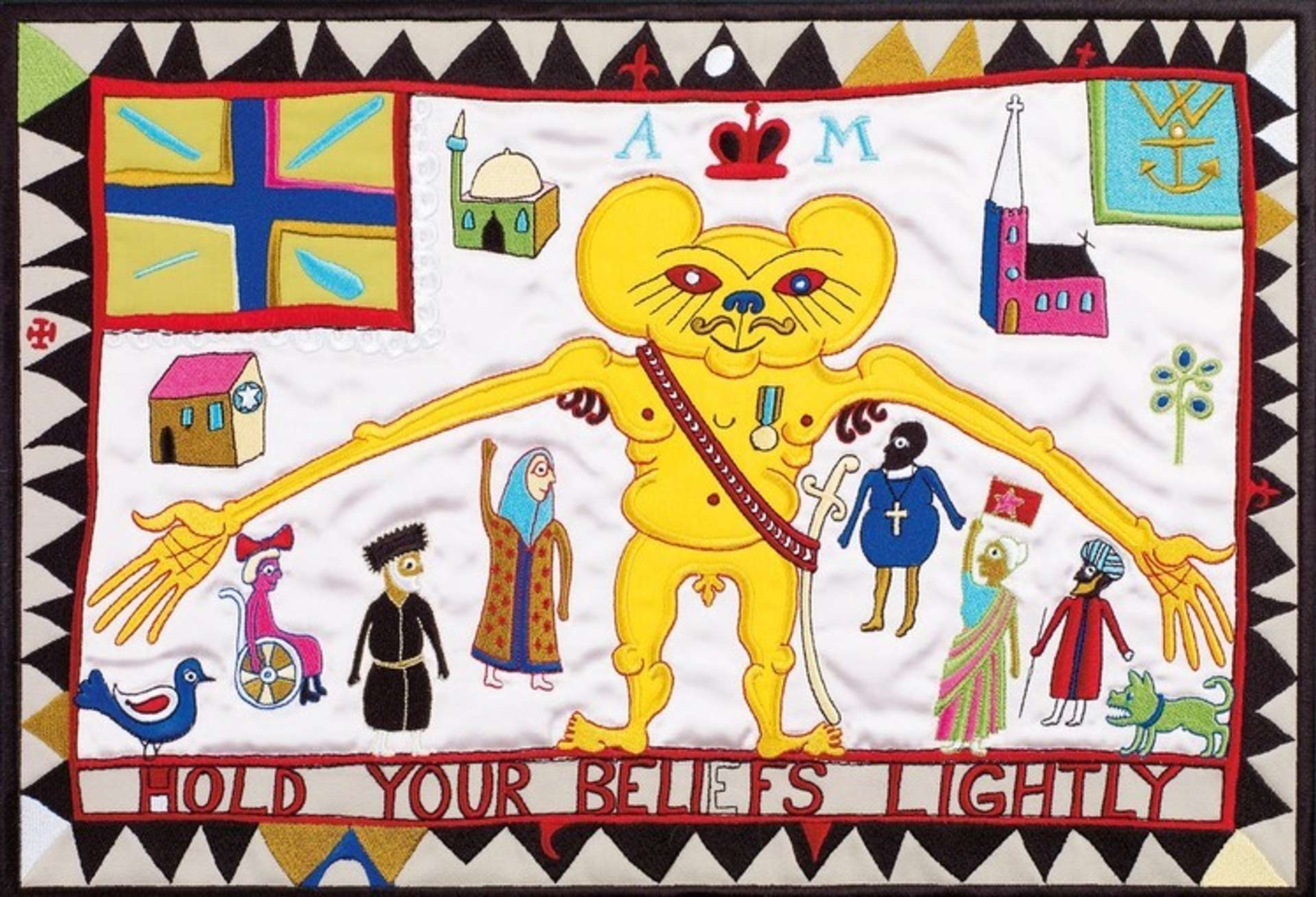 A Map Of Days © Grayson Perry 2013
A Map Of Days © Grayson Perry 2013
Grayson Perry
34 works
Sir Grayson Perry's influence has only deepened since the mid-2010s. Knighted in 2023, and celebrated as a Turner Prize recipient and Commander of the Order of the British Empire (along with his alter-ego Claire), Perry is renowned for his eccentric and politically charged artworks. In 2025 he arrived at the Wallace Collection with Delusions of Grandeur: a swaggering suite of new ceramics, tapestries, furniture and alter-ego play. He still smuggles difficult subjects into beautiful objects; what’s changed is the scale. The work now feels larger and more social: a national conversation conducted in glaze, wool and wry asides.
 Image © Christie's / We've Found The Body Of Your Child © Grayson Perry 2000
Image © Christie's / We've Found The Body Of Your Child © Grayson Perry 2000We’ve Found The Body Of Your Child (2000)
Famed for his distinctive pottery, Perry produced the ceramic vase, We’ve Found The Body Of Your Child, in 2000. Drawing inspiration from Brueghel's paintings and the haunting narrative of Tom Waits' song Georgia Lee, this work encapsulates a complex story of sorrow and ambiguity. The vase is inscribed with phrases such as ‘Never have kids’, hinting at neglectful attitudes toward children and reflecting a critical commentary on how society often dismisses the seriousness of child welfare.
 Image © Christie's / Golden Globes © Grayson Perry 2000
Image © Christie's / Golden Globes © Grayson Perry 2000Golden Ghosts (2000)
Presented in Perry's 2003 Turner Prize Exhibition, Golden Ghosts is a poignant work blending autobiographical elements with historical imagery. The vase, featuring Claire and ethereal child figures, draws on Greek and folk art traditions, embodying Perry's use of pottery's understated communicative power. The refined line work exemplifies his intent to convey messages with subtlety rather than overt statements. This piece, highlighting Perry's nuanced exploration of identity and memory, was auctioned at Christie's London in October 2018, fetching £175,000.
 Image © Christie's / Golden Globes © Grayson Perry 2003
Image © Christie's / Golden Globes © Grayson Perry 2003Barbaric Splendour (2003)
Barbaric Splendour exemplifies Grayson Perry's signature combination of classical ceramic forms with incisive social commentary, featuring a vivid portrayal of class and consumerism through a northern working-class town setting. Perry's work intricately incorporates personal elements, such as a memorial to his alter-ego Alan Measles, challenging traditional perceptions of ceramics. Highlighting the artwork's significance in the contemporary art scene and its contribution to discussions of class and aesthetics, Barbaric Splendour was auctioned for £224,750 at Christie's London in March 2018.
 Image © Christie's / Saint Claire 37 Wanks Across Northern Spain © Grayson Perry 2003
Image © Christie's / Saint Claire 37 Wanks Across Northern Spain © Grayson Perry 2003Saint Claire 37 Wanks Across Northern Spain (2003)
Crafted the same year Perry was honoured with the Turner Prize, this provocatively titled ceramic vase showcases his feminine alter-ego, Claire. This glazed urn sold for a remarkable £200,000 at Christie's London in October 2017. Inspired by Perry's cycling pilgrimage in Northern Spain, it blends religious art influences with Perry’s sexual fantasies, featuring worn paintwork effects, low relief figures, and a mix of landscape drawings including the Santiago cathedral. Perry's work subversively intertwines sexuality, religious artistry, and personal experiences, challenging pottery's decorative and utilitarian confines.
 Image © Artificial Gallery / Vote Alan Measles For God © Grayson Perry 2008
Image © Artificial Gallery / Vote Alan Measles For God © Grayson Perry 2008Vote Alan Measles For God (2008)
This 2008 wool needlepoint tapestry by Perry elevates his childhood teddy bear, Alan Measles, as a symbol of divinity amidst a tapestry crowded with symbols of war, terrorism, and global unrest. Alan Measles, wearing a suicide bomber's vest and wielding a weapon, is pointedly depicted on the Twin Towers, surrounded by a chaotic amalgam of political and cultural icons. Blending personal narrative with poignant moments of global unrest, this complex artwork showcases Perry's mode of commentary on masculinity and authority.
 Image © The Nosy Crow Ltd / The Rosetta Vase © Grayson Perry 2011
Image © The Nosy Crow Ltd / The Rosetta Vase © Grayson Perry 2011The Rosetta Vase (2011)
The Rosetta Vase (2011), is a ceramic masterpiece reflecting the artist's contemplation on culture and history, inspired by the British Museum's collections. Its ovoid form and bright yellow ground serve as a canvas for blue painted designs and incised decorations, featuring motifs like the Museum as a Tree of Life. Echoing the intricacies of ancient artefacts, the vase is adorned with slip-trailed linear motifs and Perry's signature potter's mark, crafting a dialogue between past and present cultural narratives.
A Vanity Of Small Differences (Complete Set) (2012)
Perry's The Vanity of Small Differences (2012), a series of six tapestries, delves into British social classes and aesthetic tastes, drawing inspiration from his nationwide explorations for documentary series. Inspired by Hogarth's A Rake's Progress, Perry weaves a narrative through the class journey of Tim Rakewell, incorporating real-life encounters from Sunderland to The Cotswolds. This tapestry collection, renowned for its detailed depiction of contemporary life, tackles themes of identity, British class system, and status symbols, blending autobiographical elements with broader societal observations.
A Map Of Days (2013)
In A Map of Days, Perry transforms a self-portrait into a detailed map of a fortified town, charting his personality, life events, and the relationship between the human experience and the construct of time. This large-scale etching, encased in a carefully chosen silver frame, invites viewers to explore Perry's identity through intricate details and autobiographical content. Perry incorporates both personal and universal themes, blending humour with a keen observation of the human desire to organise the chaotic aspects of life. His fascination with maps and cartography is evident, as he humorously assigns names to emotional states and life challenges, drawing inspiration from historical city plans to create a layered narrative of his inner and outer worlds.
 Image © Paragon Press / Comfort Blanket © Grayson Perry 2014
Image © Paragon Press / Comfort Blanket © Grayson Perry 2014Comfort Blanket (2014)
Perry's tapestry titled Comfort Blanket from 2014 offers a vibrant, metaphorical portrait of Britain, envisioned as a security blanket that provides stability. The work, extending to 8 metres and modelled after a British ten-pound note, incorporates quintessentially British symbols like the Queen and a cup of tea, juxtaposed with nostalgic elements such as The Archers radio drama and the characteristic British rain. Inspired by a personal narrative of refuge, Perry's tapestry delves into the nation's cultural identity, blending everyday and iconic images to explore the nuances of what it means to be British today, thus inviting reflection on national pride and its contradictions.
 Image © Artsy / The Death Of A Working Hero © Grayson Perry 2016
Image © Artsy / The Death Of A Working Hero © Grayson Perry 2016Death Of A Working Hero (2016)
Death Of A Working Hero, a tapestry made in 2016, is a poignant component of the Grayson Perry: All Man series, which delves into modern masculinity. Inspired by the Durham Miners' Gala and the ceremonial blessing of trade union banners, Perry crafts an image blending a miner and a boxer with a scene of communal mourning, symbolising the passing of traditional male roles. This tapestry, alongside Perry's reflections in his book The Descent Of Man, invites contemplation on the evolving landscape of male identity in contemporary society, highlighting the transition from binaried gender roles to more sensitive understandings of modern masculinity.







